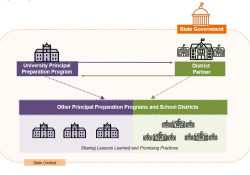What’s the biggest change we can make to improve student learning?
A new study provides useful insights to illustrate specific practices that answer this question. The study — by Learning First, in cooperation with the Center on International Education Benchmarking and funded by the National Center on Education and the Economy with support from the Bill & Melinda Gates Foundation — provides evidence that continuous professional learning deeply embedded into the framework of schools is fundamental to student success.
Beyond PD: Teacher Professional Learning in High-Performing Systems examines teacher professional learning practices and identifies common patterns across four high-performing school systems: Singapore, Shanghai, Hong Kong, and British Columbia. Each of these systems implemented major education reforms that raised student success — and each embedded concomitant professional learning into the routine daily work of teachers.
Here’s how they did it.
Improvement cycle
High-performing systems ground professional learning within an improvement cycle that ties professional learning to student learning. The three-step cycle guides continuous, school-based, and collaborative professional learning as a routine practice within the daily work life of teachers.
The three-step improvement process begins with teachers collaboratively analyzing students’ learning needs to determine what students need to learn next in their journey toward achieving success. With student learning needs identified, teachers examine their pedagogical practices; acquire or develop new practices; or refine, expand, or extend their existing practice to achieve student learning goals.
In the last step of the improvement cycle, after applying their new learning within their classrooms, observing each other’s classrooms, and giving and receiving feedback, teachers evaluate the impact of their professional learning on student learning and use that assessment to adjust subsequent instruction.
The improvement cycle creates a culture of continuous professional learning that recognizes teacher expertise and promotes ongoing school-based research about how to improve student learning. It emphasizes that school improvement is a process of professional learning. Successful professional learning requires time within the workday for teacher learning, distinct leadership roles within and across schools, and new approaches to accountability and evaluation for performance.
Web of support
High-performing school systems surround schools with a multilayered web of support for effective professional learning. They develop and position professional learning leaders to lead improvement within the schools. These leaders include teachers who provide content and pedagogical expertise within schools to extend professional learning.
Professional learning leaders, most often teachers with advanced expertise and prepared for leadership responsibilities, provide coaching, mentoring, feedback, and team- and classroom-based support for effective professional learning. School administrators, teacher leaders, and teachers are held accountable for the quality of the improvement practices. Supervisory and evaluation procedures place substantive emphasis on educators’ role and engagement in professional learning.
At the system level, a team of technical assistance providers supports teachers, teacher leaders, and school administrators in leading and facilitating effective professional learning. School systems deploy professional learning, content, and pedagogy experts who develop the capacity of teacher leaders and school administrators to fulfill their responsibilities related to professional learning. School systems access external expertise to extend school- and system-based professional learning and strive to monitor the quality of external support.
High-performing systems, despite their geographical and cultural differences, use common programs for professional learning, including learning communities, mentoring and beginning teacher initiatives, and outside courses and workshops provided by external experts. While varied within each system, the programs have commonalities that link them.
The importance of policy and conditions
The improvement cycle, professional learning leadership, and common programs are insufficient alone to increase the effectiveness of professional learning. For the professional learning to work, high-performing school systems implemented policies that place evaluation of and accountability for professional learning as a centerpiece in teacher, principal, and school performance management systems.
Professional learning sits at the center of school improvement efforts. High-performing systems allocate resources such as time and systemic structures alongside leadership and programs to provide the conditions for successful professional learning. School and system efforts build necessary infrastructure for effective professional learning to be routine.
Applying the lessons
Can these lessons inform professional learning in the U.S.? In short: Yes.
There are challenges to address, yet many schools and systems have successfully found work-arounds. One challenge is the time available for professional learning within teachers’ workday. Another is the current accountability and evaluation policies that focus on criteria other than effective professional learning.
In the U.S., policies place accountability for individual teacher performance on personnel evaluation systems rather than on school and system leaders for the implementation of effective professional learning as occurs in the high-performing school systems studied. And, given the timing, the study provides useful insights both federal and state education agencies can use to establish new guidelines for professional learning for implementation of the Every Student Succeeds Act.
This report offers not only lessons from high-performing school systems but also accompanying online tools and artifacts gathered during the research. These resources will be useful to system and school leaders in adjusting their current professional learning practices to increase its impact on teacher practice and student learning.
The Facilitator Guide for Beyond PD: Teacher Professional Learning in High-Performing Systems,developed by Learning Forward, will be available soon so stakeholders such as teachers, teacher leaders, principals, system leaders, and policymakers can extend their study of the research report and initiate improvements in their professional learning practices.
As Learning Forward has long advocated, the success of any education reform depends on effective professional learning. Let’s use these new lessons to advance results for all of the learners in our school systems and schools.
This post originally appeared in Learning Forward’s PD Watch.



![Poil blog v1[1]](https://learningforward.org/wp-content/uploads/bb-plugin/cache/poil-blog-v11-custom_crop.jpg)




